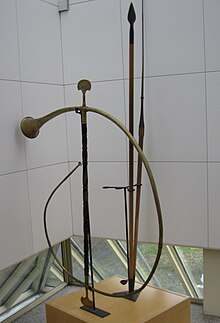| This article needs additional citations for verification. Please help improve this article by adding citations to reliable sources. Unsourced material may be challenged and removed. Find sources: "Tubilustrium" – news · newspapers · books · scholar · JSTOR (December 2009) (Learn how and when to remove this message) |
In Ancient Rome the month of March was the traditional start of the campaign season, and the Tubilustrium was a ceremony to make the army fit for war. The ceremony involved sacred trumpets called tubae.

Johannes Quasten, however, argues that the common term for war trumpets being tubae is not the same as the tubi form here. He states that tubi was only used for trumpets used in sacrifices and goes on to show how this ceremony was a feast to cleanse and purify the trumpets used in sacrifices - it is a good example, he argues, of the special connection between music and cult in Roman ritual.
The festival was held on March 23, the last day of the Quinquatria festival held in tribute to the Roman God Mars and Nerine, a Sabine goddess. The event took place again on May 23.
The ceremony was held in Rome in a building called the Hall of the Shoemakers (atrium sutorium) and involved the sacrifice of a ewe lamb. Romans who did not attend the ceremony would be reminded of the occasion by seeing the Salii dancing through the streets of the city.
Notes
- Jörg Rüpke (4 February 2011). The Roman Calendar from Numa to Constantine: Time, History, and the Fasti. John Wiley & Sons. pp. 30–. ISBN 978-1-4443-9652-2.
- J.Quasten, 1983, Music & Worship in Pagan & Christian Antiquity, p.6-7
- J.Quasten, 1983, Music & Worship in Pagan & Christian Antiquity, p.8
- Gareth Sears; Peter Keegan; Ray Laurence (18 July 2013). Written Space in the Latin West, 200 BC to AD 300. A&C Black. pp. 90–. ISBN 978-1-4411-8876-2.
- L. Richardson, jr (1 October 1992). A New Topographical Dictionary of Ancient Rome. JHU Press. pp. 42–. ISBN 978-0-8018-4300-6.
| Roman festivals and games (ludi) | |
|---|---|
|
This article about the military history of ancient Rome is a stub. You can help Misplaced Pages by expanding it. |
This article about a religious festival is a stub. You can help Misplaced Pages by expanding it. |
